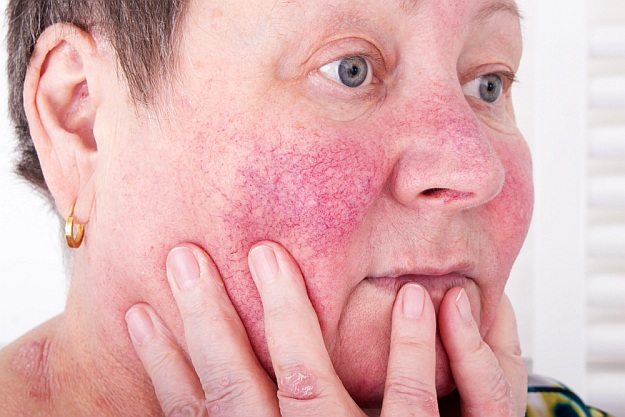

If you suffer from rosacea, you understand the discomfort and insecurity that so often accompany its effects. Fortunately, you have plenty of options for combatting this irritable skin condition. A lot of these options fall under the category of rosacea natural treatment.
Many physicians recommend pharmaceutical products, but it’s not always acknowledged that there are other paths to try. Like any medical condition, it’s best to understand all of the potential options. This is not to say that medication is a bad idea. It is simply helpful to know what else you can do to address the problem, or perhaps to remedy it completely, on your own.
Read on to learn more about rosacea, its different types, the effects on your skin, and the various rosacea natural treatments and remedies available to you. By the end of the article, you will have the information necessary to make a difference in your rosacea at home and to determine whether you should seek medical treatment from a physician.
WHAT ROSACEA NATURAL TREATMENT CAN YOU TRY AT HOME?
In this article:
- What Is Rosacea?
- Types of Rosacea
- What Are the Symptoms?
- What Triggers Rosacea?
- Treatments Physicians Frequently Prescribe
- Natural Methods for Calming Rosacea
- When Should You See a Doctor?
WHAT IS ROSACEA?
Rosacea is a common skin condition related to adult acne, and it is estimated to affect roughly 415 million people worldwide. It causes redness in its initial stages, though in more severe stages it can cause changes in skin topography (bumps and swelling) and manifest as blood vessels on the surface.
The condition may arise from many root complications, including immune system overreactions, incorrect processing of the protein cathelicidin, previous history of acne, and genetic predispositions.
New evidence indicates that the problem may result from Demodex mites, a genus that lives on eyelashes that may cause skin problems. While Demodex folliculorum typically affects hair follicles (hence their prevalence in human eyelashes), Demodex brevis resides in human sebaceous glands.
These are responsible for secreting oil on the face and skin. Although no conclusive evidence has yet to be established, studies show that people with rosacea have higher numbers of these mites.
Further research demonstrates that rather than the mites themselves, the problem may actually stem from Bacillus oleronius, a type of bacteria often found in proximity to the mites.
Whatever the case, it’s important to understand the type of rosacea afflicting you in order to treat it most effectively. That includes knowing the symptoms and the triggers of rosacea.
TYPES OF ROSACEA

The American Academy of Dermatology breaks down rosacea into four subcategories:
- Erythematotelangiectatic rosacea: This type of rosacea is most commonly associated with the condition, and it includes redness, flushing, and clear blood vessel patterns.
- Papulopustular rosacea: The condition proceeds from the first subcategory into swelling and breakouts on the skin.
- Phymatous rosacea: In this stage, skin thickens and grows bumpy.
- Ocular rosacea: As the name suggests, this type of rosacea affects the eyelids, resulting in swollen red bumps that look like styes.
Each is associated with different rosacea symptoms.
WHAT ARE THE SYMPTOMS?
All types of rosacea share some similar symptoms, most notably redness of the skin. However, each chronic skin condition carries different traits.
Subtype 1 manifests as flushing and swollen skin, visibly broken vessels, and a tendency to blush more easily than others. Individuals who suffer from this subtype may feel stinging or burning sensations, and they may have very dry skin and experience high sensitivity.
Subtype 2 progresses to acne-like flare-ups, usually where skin patches are reddest. The skin also carries other conditions of acne, such as extreme oiliness and raised patches called plaques. This subtype also involves extreme sensitivity.
Thickening skin accompanies Subtype 3, as does a bumpy texture. Skin can thicken on the forehead, cheeks, chin, and ears. Though, it is most common on the nose. When nose skin thickens considerably, it is called rhinophyma.
Subtype 4 is a condition of the outer eye. It may make eyes water or become red, and as noted above, often looks like cysts on the lower or upper lids. The sufferer may experience blurry vision, a gritty feeling, itchiness, and extreme sensitivity.
All of these symptoms affect quality of life, both reducing confidence and resulting in physical discomfort.
The first approach to managing rosacea is to understand what makes you prone to it. In other words, your triggers.
WHAT TRIGGERS ROSACEA?
Understanding what triggers rosacea and facial redness gives you a better chance of reducing flare-ups without having to use costly or chemical-based medical treatments. Many people find their rosacea worsens with:
- Exposure to sunlight
- Stress
- Heat
- Consumption of alcohol in general
- Consumption of red wine specifically
- Spicy foods
- Inflammation from food allergies
- Allergic reactions of any kind
- Some kinds of makeup, especially cheap products
- Other skin and hair products
- Wind
- Cold weather
- Medicinal reactions
- Overly hot baths and showers
- Exercise
Naturally, no one is suggesting you give up exercise, but you may need to institute a routine of immediately washing and applying soothing products to your facial skin after finishing a workout (see natural products in the next section). If you find that spicy foods, or other foods to which you react, make rosacea worse, you can cut them out. This also goes for heat, cold, stress, and sunlight, to name a few of many potential triggers.
It might sound overwhelming to chart how triggers make you react, but this is where the Rosacea Diary Booklet comes in. This handy checklist helps you track weather conditions, foods, activities, emotional states, products, and medical compliance in relation to your rosacea. Over a period of a few weeks, you can start to discover the patterns that make your skin redden and break out. Then, you can make much more tailored lifestyle changes.
However, if your rosacea doesn’t seem to respond to changes in lifestyle – or doesn’t respond adequately enough – it’s time to seek alternative remedies. While a number of medical approaches exist, alternative treatments may be more preferable, depending on your specific situation.
TREATMENTS PHYSICIANS FREQUENTLY PRESCRIBE
Only a few medical treatments for rosacea have proven effective. These include acne medications, both topical and oral. Topical medications usually don’t show results until around 3 weeks after the initial application. Also, keep in mind that oral medications are dangerous to fetuses.
Your doctor may also suggest antibiotics, but unless your health is in danger from severe infection, it may not be advisable to use antibiotics. This course of action increases antibiotic resistance and can result in superbugs that don’t respond to antibiotic treatments. At least 23,000 people die each year from antibiotic-resistant infections in the US, so avoid them whenever possible.
NATURAL METHODS FOR CALMING ROSACEA

Any time you can use cheap, readily available, home-based natural remedies, why wouldn’t you? The good news is that, in addition to making changes in lifestyle, you can take many steps at home to reduce the symptoms of your condition:
- Anti-inflammatory foods: Eating foods that calm inflammation and boost your immune system is critical. Some of the best options include bone broth, beets, blueberries, cruciferous vegetables, coconut, ginger, pineapple, turmeric, walnuts, and fatty fish.
- Apple cider vinegar: Add one teaspoon of apple cider vinegar to a cup of water and honey if desired. Drink this every morning to help balance internal pH levels and reduce symptoms. You can also apply vinegar directly to the face as an antibacterial astringent.
- Green tea: Evidence indicates that drinking green tea can help you fight off infections and boost your immunity.
- Essential oils: Applying some oils to your face topically may help. These include lavender oil and tea tree oil. Make sure when applying essential oils to dilute them in a carrier oil such as olive, almond, or coconut. That means roughly 12 drops of essential oil to each ounce of carrier oil, otherwise, you risk irritating your face more.
- Herbs and supplements: A variety of herbs and supplements exist to help calm rosacea symptoms. These include B-complex vitamins, enzymes, and plant-based remedies.
If lifestyle changes and natural remedies for rosacea fail, it might be time to see a doctor for a more extreme approach.
WHEN SHOULD YOU SEE A DOCTOR?
Now that you know some of the more important facts about rosacea and its various treatment options, you’re likely wondering when its time to transition from one to the other.
The answer is, when natural remedies fail, it’s time to see a doctor. Some people have such extreme cases of rosacea and such sensitive skin that nothing short of medical intervention will work. While it’s still useful to practice management through lifestyle adjustments and natural treatments, and you shouldn’t give those up simply because you take a medical approach as well, you might not see success without the latter.
Rosacea has the capacity to compromise your productivity and your self-confidence, but only if you let it. Take back your day with our proven Mother of all Creams, trusted by more than 300,000 households all over the globe for its plant-rich approach to naturally hydrated skin.
Here are 4 rosacea natural treatment options you can follow and try at home.
Whether your rosacea concerns are your own or in response to a child, spouse, family member, or friend who is suffering, there is an answer. The takeaway is this: There are many solutions, and if you look, you’ll find the right one for you. It is a helpful practice to begin with rosacea natural treatment. The positive changes that accompany holistic treatment will likely bring their own rewards, even if you need to keep looking to solve your rosacea.
